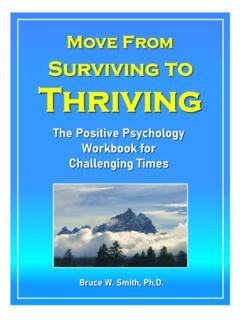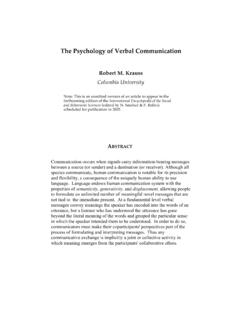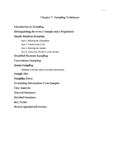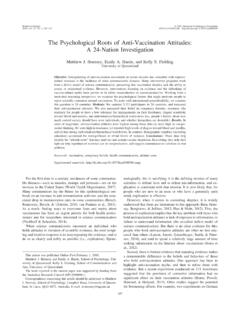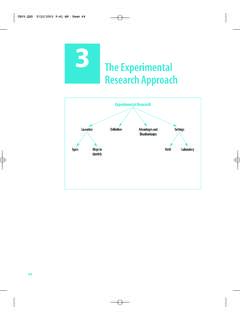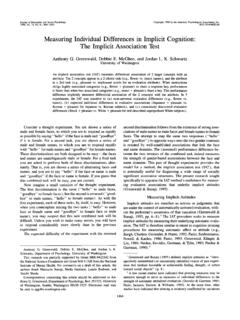Transcription of AP Psychology Study Guide
1 History and Approaches (2-4%) Psychology is derived from physiology (biology) and philosophy EARLY APPROACHES oStructuralism used INTROSPECTION (act of looking inward to examine mental experience) to determine the underlying STRUCTURES of the mind oFunctionalism need to analyze the PURPOSE of behavior APPROACHES KEY WORDS oEvolutionary Genes oHumanistic free will, choice, ideal, actualization oBiological Brain, NTs oCognitive Perceptions, thoughts oBehavioral learned, reinforced oPsychoanalytic/dynamic unconscious, childhood oSociocultural society oBiopsychosocial combo of above PEOPLE: oMary Calkins: First Fem. Pres. of APA oCharles Darwin: Natural selection & evolution oDorothea Dix: Reformed mental institutions in oStanley Hall: 1st pres.
2 Of APA1st journal oWilliam James: Father of American Psychology functionalist oWilhem Wundt: Father of Modern Psychology structuralist oMargaret Floy Washburn 1st fem. PhD oChristine Ladd Franklin 1st fem. Research Methods (8-10%) EXPERIMENT : Adv: researcher controls variables to establish cause and effect Disadv: difficult to generalize oIndependent Variable: manipulated by the researcher Experimental Group: received the treatment (part of the IV) Control Group: placebo, baseline (part of the IV) Placebo Effect: show behaviors associated with the exp. group when having received placebo Double-Blind: Exp. where neither the participant or the experimenter are aware of which condition people are assigned to oDependent Variable: measured variable (is DEPENDENT on the independent variable) Operational Definition: clear, precise, typically quantifiable definition of your variables allows replication Confound: error/ flaw in Study Random Assignment: assigns participants to either control or experimental group at random minimizes bias, increase chance of equal representation Random Sample: method for choosing participants minimizes bias Validity: accurate results Reliability: same results every time NATURALISTIC OBSERVATION: Adv.
3 Real world validity (observe people in their own setting) Disadv: No cause and effect CORRELATION: Adv: identify relationship between two variables Disadv: No cause and effect (CORRELATION DOES NOT EQUAL CAUSATION) oPositive Correlation Variables vary in the same direction oNegative Correlation variables vary in opposite directions oThe stronger the # the stronger the relationship REGARDLESS of the pos/neg sign CASE Study : Adv. Studies ONE person (usually) in great detail lots of info Disadv: No cause and effect DESCRIPTIVE STATS:shape of the data oMeasures of Central Tendency: Mean: Average (use in normal distribution) Median: Middle # (use in skewed distribution) Mode: occurs most often INFERENTIAL STATISTICS: establishes significance (meaningfulness) significant results = NOT due to chance ETHICAL GUIDELINES (APA) oConfidentiality oInformed Consent oDebriefing oDeception must be warranted Biological Basis (8-10%) NEURON: Basic cell of the NS oDendrites: Receive incoming signal oSoma: Cell body (includes nucleus) oAxon: AP travels down this oMyelin Sheath.
4 Speeds up signal down axon oTerminals: release NTs send signal onto next neuron oSynapse: gap b/w neurons Action Potential: movement of sodium and potassium ions across a membrane sends an electrical charge down the axon oAll or none law: stimulus must trigger the AP past its threshold, but does not increase the intensity of the response (flush the toilet) oRefractory period: neuron must rest and reset before it can send another AP (toilet resets) Sensory neurons receive signals Afferent neurons Accept signals Motor neurons send signals Efferent neurons signal Exits CENTRAL NS: Brain and spinal cord PERIPHERAL NS: Rest of the NS oSomatic NS: Voluntary movement oAutonomic NS: Involuntary (heart, lungs, etc) Sympathetic NS: Arouses the body for fight/flight (generally activates) Parasympathetic NS: established homeostasis after a sympathetic response (generally inhibits) AP Psychology Study Guide NEUROTRANSMITTERS (NTS): Chemicals released in synaptic gap, received by neurons oGABA: Major inhibitory NT oGlutamatE: Major Excitatory NT oDopamine: Reward & movement oSerotonin: Moods and emotion oAcetylcholine (ACh): Memory oEpinephrine & Norepinephrine: sympathetic NS arousal oEndorphins: pain control, happiness oOxytocin: love and bonding Agonist: drug that mimics a NT Antagonist: drug that blocks a NT Reuptake.
5 Unused NTs are taken back up into the sending neuron. SSRIs (selective serotonin reuptake inhibitors) block reuptake treatment for depression AREAS OF THE BRAIN: Hindbrain: oldest part of the brain oCerebellum movement (what does it take to ring a bell) oMedulla vital organs (HR, BP) oPons sleep/arousal (Ponzzzzzz) Midbrain oReticular formation: attention (if you can t pay attention, You R F d) Forebrain: higher thought processes oLimbic System Amygdala: emotions, fear (Amy, da! You re so emotional!) Hippocampus: memory (if you saw a hippo on campus you d remember it!) oThalamus: relay center oHypothalamus: Reward/pleasure center, eating behaviors oBroca s Area: Inability to produce speech (Broca Broken speech) oWernicke s Area: Inability to comprehend speech (Wernicke s what?)
6 OCerebral Cortex: outer portion of the brain higher order thought processes Occipital Lobe: located in the back of the head - vision Frontal Lobe: decision making, planning, judgment, movement, personality Parietal Lobe: located on the top of the head - sensations Temporal Lobe: located on the sides of the head (temples) hearing and face recognition Somatosensory Cortex: map of our sensory receptors in parietal lobe Motor Cortex: map of our motor receptors located in frontal lobe oCorpus Callosum: bundle of nerves that connects the 2 hemispheres sometimes severed in patients with severe seizures leads to split-brain patients Lateralization: the brain has some specialized features language is processed in the L Hemisphere Split-brain experiments: done by Sperry & Gazzanaga.
7 Images shown to the right hemisphere will be processed in the left (& vice versa), patient can verbally identify what they saw BRAIN PLASTICITY: Brain can heal itself NATURE VS. NURTURE: ANSWER IS BOTH oTwin Studies: Identical twins Monozygotic (MZ) Fraternal twins Dizygotics (DZ) oGenetics: MZ twins will have a higher percentage of also developing a disease oEnvironment: MZ twins raised in different environments show differences ENDOCRINE SYSTEM: sends hormones throughout the body oPituitary Gland: Controlled by hypothalamus. release growth hormones oAdrenal Glands: related to sympathetic NS: releases adrenaline Sensation & Perception (6 8%) ABSOLUTE THRESHOLD: detection of signal 50% of time (is it there) DIFFERENCE THRESHOLD (also called a just noticeable difference (JND) and follows WEBER S LAW: two stimuli must differ by a constant minimum proportion.)
8 (Can you tell a change?) SIGNAL DETECTION THEORY Sensory Adaptation: diminished sensitivity as a result of constant stimulation (can you feel your underwear?) Perceptual Set: tendency to see something as part of a group speeds up signal processing Inattentional Blindness: failure to notice something b/c you re so focused on another task (gorilla video) Cocktail party effect: notice your name across the room when its spoken, when you weren t previously paying attention VISUAL SYSTEM: oPathway of vision: light cornea pupil/iris lens retina rods/cones bipolar cells ganglion cells optic nerve optic chiasm occipital lobe oCornea protects the eye oPupil/iris controls amount of light entering eye oLens focuses light on retina oFovea area of best vision(cones here) oRods black/white, dim light oCones color, bright light oBipolar cells connect rods/cones and ganglion cells oGanglion cells opponent-processing occurs here oBlind spot occurs where the optic nerve leaves the eye oFeature detectors specialized cells that see motion, shapes, lines, etc.
9 (experiments by Hubel & Weisel) THEORIES OF COLOR VISION: oTrichromatic three cones for receiving color (blue, red, green) Explains color blindness - they are missing a cone type oOpponent Process complementary colors are processed in ganglion cells explains why we see an after image Visual Capture: Visual system overwhelms all others (nauseous in an IMAX theater vision trumps vestibular) Constancies: recognize that objects do not physically change despite changes in sensory input (size, shape, brightness) Phi Phenomenon: adjacent lights blink on/off in succession looks like movement (traffic signs with arrows) Stroboscopic movement: motion produced by a rapid succession of slightly varying images (animations) MONOCULAR CUES (how we form a 3D image from a 2D image) oInterposition: overlapping images appear closer oRelative Size: 2 objects that are usually similar in size, the smaller one is further away oRelative Clarity: hazy objects appear further away oTexture Gradient: coarser objects are closer oRelative Height: things higher in our field of vision look further away oLinear Perspective: parallel lines converge with distance (think railroad tracks) BINOCULAR CUES: (how both eyes make up a 3D image) oRetinal Disparity.
10 Image is cast slightly different on each retinal, location of image helps us determine depth oConvergence: Eyes strain more (looking inward) as objects draw nearer TOP-DOWN PROCESSING: Whole smaller parts BOTTOM-UP PROCESSING: Smaller Parts Whole AUDITORY SYSTEM: oPathway of sound: sound pinna auditory canal ear drum (tympanic membrane) hammer, anvil, stirrup (HAS) oval window cochlea auditory nerve temporal lobes oOuter Ear: pinna (ear), auditory canal oMiddle Ear: ear drum , HAS (bones vibrate to send signal) oInner Ear: cochlea like COCHELLA (sounds 1st processed here) THEORIES OF HEARING: both occur in the cochlea oPlace theory location where hair cells bends determines sound (high pitches) oFrequency theory rate at which action potentials are sent determines sound (low pitches) OTHER SENSES: oTouch: Mechanoreceptors spinal cord thalamus somatosensory cortex oPain: Gate-control theory: we have a gate to control how much pain ix experienced oKinesthetic: S


